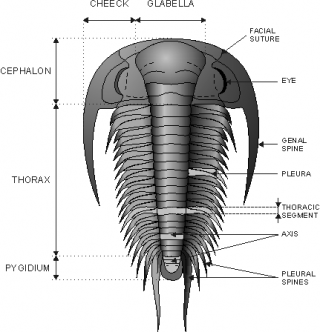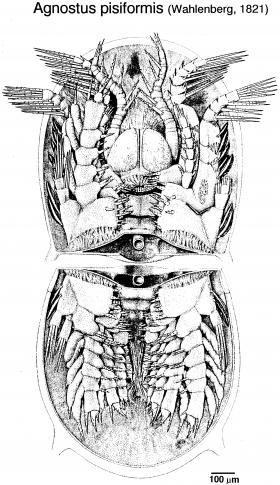Trilobites (Trilobita)
Trilobites represent extinct, exclusively marine group of arthropods restricted to the Palaeozoic. Dorsal surface of trilobite body was protected by morphologically very typical exoskeleton on which head, thorax and pygidium could be distinguished longitudinally. Similarly, three different parts are possible to distinguish in transverse direction. Such trilobation is responsible for their name, tres = three, lobus = lobe.
Trilobites usually measure between several milimetres and several centimetres in length, but some of them reached up to 75 cm in length. Cephalon is usually more or less convex both longitudinally and transversally. Longitudinal trilobation of the cephalon gives rise to the axial region (glabella and occipital ring), while two lateral (genal) regions commonly carry the compound eyes. Facial sutures usually transect the cephalon. Thorax (body) is composed of several up to more than one hundred thoracic segments that were connected in a complicated articulating apparatus. Such a movable connection makes enrolment possible, which was probably a protective reaction. Pygidium, the posterior part of the animal reached different dimensions, in some taxa it could bear a terminal axial spine. Each thoracic segment was ventrally provided with a pair of segmented appendages. On thoracic and pygidial appendages two parts are distinguished, exopodite and endopodite. In exopodite, a respiration function is supposed, while morphology of the endopodite fits well with its locomotive function. The cephalic apendages were morphologically modified. The first pair of ventral cephalic limbs was transformed into segmented antennae; the next four pairs were used to catch and/or select and process food. The digestive system is not very well known. On the ventral side, below the posteral part of hypostome, the mouth was placed. The segmented stomach was supposedly disposed in the posteral portion of the glabella and also in several anteriormost thoracic segments, being followed by simple gut, which ended in an anal aperture on the lower side of pygidium. Most trilobites had a pair of dorsal, usually compound eyes, but some of them were secondarily blind. The ventral exoskeleton of trilobites consists of a thin integument and comparatively soft chitinous layer. Dorsal exoskeleton was heavily mineralised (mainly by CaCO3) and that is why trilobite remains are often preserved in Cambrian to Permian marine sediments. The trilobites are known from the Early Cambrian (534 Ma), but not from the lowermost levels. However, during the lower Cambrian and the Ordovician this group radiated successfully. In the Cambrian the trilobites formed more than 60 % of the preserved faunal remains. By the end of the Cambrian, near the Ordovician/Silurian boundary, in the Silurian and mainly during the Devonian, trilobites suffered several mass extinctions. After these crises, the surviving forms recovered. However, trilobite diversity decreased since the end of the Ordovician. The last representatives disappeared in the Late Permian (e.g., about 251 Ma ago). Trilobites thus did not reach a massive extinction along the Permian/Triassic border, which probably was the largest extinction event in the geological history of the Earth. Fossilized remains of trilobites are very attractive in numerous museums, institutional and private collections. AgnostidsA very problematic group are agnostids. They are (conservatively) considered as an order of trilobites. Prof. Waloszek in Müller & Walossek (1987), however, published very interesting study about the agnostide morphology (see Fig.2). The agnostids are considered by him and by many other specialists as specialised arthropods related rather to the crustaceans then trilobites. The main reasons are very different appendages of agnostids, the lack of dorsal eyes, lack of facial suture and some other features.The author of the text (P. Budil) share the opinion of Prof. Waloszek. Many visitors of the Virtual museum, however, would expect agnostids on the same web page like trilobites. Therefore, they are ehibited together and their possibly separate systematic position is explained by this short text.Source: Budil a Fatka (2008) An excellently preserved specimen of Agnostus pisiformis. Courtesy of Prof. Dieter Waloszek Rozdělení exponátů dle abecedního názvu A B C D E F G H I J K L M N O P Q R S T U V W X Y Z | ||
Virtual museum of the Czech Geological Survey, www.geology.cz, (C) Czech Geological Survey, 2011, v.0.99 [13.12.2011]


![[ENG]](img/vlajka-cr.gif) Česky
Česky 

